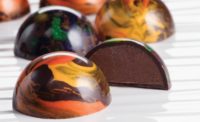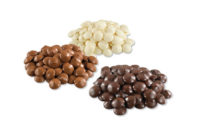An Olam customer recently asked the company’s food scientists for a compound coating that didn’t lighten the color of their chocolate.
Wouter Stomph, senior manager of product development and innovation for Olam Americas Inc., says the one they were using was alkalized, and consumers didn’t want that on the label. However, when they used a non-alkalized compound coating, the chocolate wasn’t as dark as their original product.
Stomph had a solution, though — Olam’s new TrueDark cocoa powder. The natural, dark, nonalkalized cocoa powder can be labelled simply as “cocoa,” so it can be used for clean labels.
“TrueDark, the first dark natural (non-alkalized) cocoa powder to offer a rich brown color and a balanced cocoa flavor, enables the creation of clean-label, natural ingredient statements for compound coating and spread applications,” he explains. “D11S, D11CD and D11SQ are dark cocoa powders for dark chocolate compound coatings. D11S offers a reddish-brown color combined with a full-bodied cocoa flavor; D11CD delivers an intense, dark-red color with smooth, dark chocolate flavor; and D11SQ provides a dark-brown color with intense dark chocolate flavor.”
Compound coatings aren’t meant for solid chocolate bars, but they do have their uses.
“The versatility of compound coatings is enormous, allowing you to create everything from chocolate-flavored coatings for ice creams, biscuits and fruit to delightful soft spreads, and also chocolate-like confectionery products, such as bars,” Stomph explains. “Compound coatings are also used for enrobing, moulding and filling.”
And Olam also offers milk chocolate compound coating options.
“Our milk chocolate compound coating offering includes N11N and D11DQ, which are natural and lightly alkalized respectively, and which provide a light-brown color and soft, smooth cocoa notes,” Stomph says.
Blommer also recently launched two new lines of coatings, Wonderline and Proteos30, says Alex Funk, R&D senior scientist at Blommer.
The Wonderline coatings offer a 35 percent reduction in calories and more than a 60 percent reduction in saturated fat (and overall fat) while maintaining the taste and texture of their full-calorie counterparts. The product is available in white, milk, dark, yogurt and sugar-free (which delivers over 50 percent reduction in total calories).
They also recently launched the Proteos30 line, which “delivers a minimum of 30 percent protein on a per gram basis, which as you can imagine, is quite difficult to achieve without our proprietary formulations and processing knowledge,” Funk explains. “Protein has been a mainstream trend for a few years now, and we found that compound coatings are a great way to deliver even more protein to our customers’ applications. In the new line we offer milky white, tangy yogurt, creamy milk and rich dark coatings.”
Zachary Freed, AAK customer innovation applications specialist, confectionery, says healthy eating is also part of the reason for its innovation among compound coatings.
“With eating healthy on everyone’s mind, AAK has a line of cocoa butter substitutes which contain a lower amount of saturated fats,” Freed says. “These fats still allow for high gloss, good eating quality and can be customized for our customer’s needs.”
The company has a number of compound coatings options.
“Blends from palm and palm kernel oils are the industry go-to for compound coatings,” he says. “AAK offers CEBESTM line of high performance fats for compound coatings. Other fat sources, such as shea and coconut, will be used in cocoa butter equivalents and palm-free coatings, respectively. Many of these fats can also be modified, using fractionation, interesterification, and hydrogenation, to have different melting properties as well.”
Clean label compound coatings
There’s also a number of clean-label options.
“A company looking for cleaner labels and/or sustainable ingredients has a variety of options to choose from,” Freed says. “Partially hydrogenated fats have lost their GRAS status with the FDA, so the first step is to replace them with either fully hydrogenated or non-hydrogenated fats; the latter providing a cleaner label. With today’s consumers, non-GMO and organic ingredients are popular when looking for clean label.”
But what exactly works for clean label can be hard to navigate as it’s not one size fits all, Funk says.
“Since there is no regulation around the term ‘clean label,’ it is important for companies to determine how they define that term with their products,” she says. “Customers may want to use natural cocoa instead of those processed with alkali. Other common requests are for vanilla or natural flavors instead of vanillin, as well as natural colors to replace synthetic ones. For sugar free, we are seeing a switch from maltitol to erythritol for a more ‘clean’ label, as well as the switch from artificial sweeteners to stevia.”
And some companies also want to avoid hydrogenated oils as consumers change their opinions around hydrogenation.
At the end of the day, with all the various blends, blend ratios and fat modifications, there’s always a way to make compound coatings work for a specific product.
“With all of these options, the ‘ideal’ product to use as the fat in a compound coating very much depends on the application and the desired melting profile,” Freed says.






